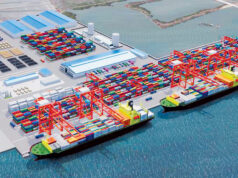By Mark Louis F. Ferrolino, Special Features Writer
With the “Build, Build, Build” infrastructure program of the Duterte administration, the cement industry is now at the forefront of the country’s economic boom. The industry has been experiencing significant progress and is expected to grow even more due to the increased investment in infrastructure that fuels demand for cement and other construction materials.
“The country is experiencing a continuing increase in cement demand,” Ernesto M. Ordoñez, president of Cement Manufacturers’ Association of the Philippines Inc. (CeMAP), was quoted as saying in the 2015 Annual Cement Industry Report. “The forecast is that local demand for cement may continue to increase in the coming years.”
Over the past years, the local cement industry has grown along with the Philippine economy. The 2017 Cement Market Report prepared by the Cement Business Advisory, which was also quoted in the Eagle Cement Corp.’s prospectus in 2017, shows that there is a tremendous growth in the country’s demand for cement.
“The increase in construction activity over the last two years was mainly driven by increased infrastructure spending by the government. Prior to 2015, construction activity was mainly supported by private investment directed to housing and commercial/industrial projects. In 2015, infrastructure spending almost doubled as a percentage of GDP (gross domestic product) and has continued to increase in 2016,” Eagle Cement said in the prospectus.
In terms of gross value and gross value added in construction, the Philippine Statistics Authority (PSA) said that the industry grew by 2.8% for the fourth quarter of 2017; slower compared with the previous year’s 10.7%. The growth was driven by the increase in public construction but was weighed down by the decline in private construction.
Based on a separate data published by PSA, it showed that the total number of construction projects in the country for the fourth quarter of 2017 rose to 33,445, or 3.6% higher than the recorded 32,282 constructions during the same quarter in the previous year.
In the same period, the number of non-residential constructions increased to 4,903. This reflects an increase of 23.2% from 3,981 recorded in 2016. The growth was brought by the increase in number of constructions in agricultural buildings with 281 (51.1%), commercial buildings with 3,129 (25.9%), other non-residential type of constructions with 109 (22.5%), industrial buildings with 554 (14.2%), and institutional buildings with 830 (12.8%).
On the other hand, the number of residential building constructions declined by 4.3% to 23,693 from the previous year’s 24,752. Residential condominiums, apartment or accessoria, single-type houses, and duplex or quadruplex showed decrements in number.
In terms of additions to existing structures, the PSA data showed an increase of 1,149 from 888 projects during the same period of 2016. Likewise, combined number of alterations and repairs of existing structures increased to 3,700 from the previous year’s 2,666.
All these construction projects require the use of cement. Thus, the cement industry serves as the partner of the country in transforming its aspirations into realities and in building its future. Also, with the number of construction activities across the Philippines, more investors are attracted to invest in the country.
As of December 2016, the Philippine cement industry has an estimated annual clinker and cement capacity of 20.6 and 28.63 million tonnes, respectively, according to the 2017 Cement Market Report.
Of these capacities, it could be noted that the top four industry players, namely LafargeHolcim, CEMEX, Republic Cement and Eagle Cement, account for about 80% and 82% of total clinker and cement domestic production, respectively.
Significant growth in imports of both clinker and cement that are brought by existing industry players or independent importers was observed.
Majority of imports are being sourced by existing cement players in order to augment their domestic cement production. The sources of these imports are mainly from countries in the region that experience supply overcapacity, namely China, Vietnam, Indonesia, Thailand and Malaysia.
“In 2016, almost all of the domestic manufacturers imported either clinker or cement and given that margins on local production are higher than on imported products, it would normally be expected that manufacturers would maximize local clinker production. The apparent discrepancy therefore between the quoted capacity of around 20 MT clinker and actual production of around 17 MT might lead to some doubt as to the real capability of the domestic industry to achieve the stated capacity levels. If this is the case, then there will be an additional supply shortfall that would have to be met by extra imports or new investments,” Eagle Cement said in the prospectus.
On the other hand, the company noted that the entry of independent importers are viewed to be opportunistic in nature and their long-term commitment to the market is questionable since they are yet to invest in importation assets in the country such as terminals and depots, among others.
Meanwhile, the Board of Investments (BoI) is seeking for more cement investments as it expects demand to double by 2020.
Based on the projection provided in the 2017 Cement Market Report, the industry would need an addition of about 11.55 million tons of cement capacity to address the cement consumption requirements until 2025.
“To address this demand gap, existing players may either build capacity expansions or import clinker and/or cement from abroad. The latter is especially true for multinational cement countries which have operations in nearby countries. But given the limitation on port capacity to receive imported cement, it seems that there is a significant need for the construction of additional capacity going forward to support not only the widening cement supply gap but also the continuity of economic growth in the country,” Eagle Cement said.
In general, industry players are investing on key projects to increase cement capacity in anticipation of higher demand in the following years. Behind the projected shortfall, companies remain optimistic with regard to the future of the industry.



